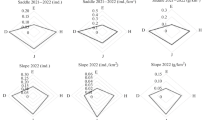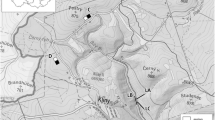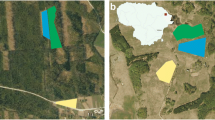Abstract
In the Cerrado savannas from Brazil fire events are common and strongly influence the vegetation structure and, consequently, the associated small mammals. In this paper, we investigate changes in the structure of small mammal communities related to sites of different post-fire ages. Mammals were captured in similar Cerrado sites that differed in time since the last burn (1 to 26 yr). We sampled six sites in the wet season of 1997 (phase 1) and, three years later, six sites in the wet and dry seasons (phase 2). Six rodent species and four marsupials were captured. Community composition changed drastically as a function of time since fire. The diversity and abundance of small mammals reached maximum values in the early successional stages. The rodent Calomys tener was present only in early seral stages. The rodent Bolomys lasiurus was more frequent in mid-successional stages and decreased in later seral stages, and the rodent Oryzomys subflavus occupied all successional stages. The marsupial Gracilinanus agilis was dominant in the area that did not burn for at least 23 yr. Changes in composition of the community of small mammals were more accelerated in early successional stages, when there are more drastic vegetational changes. The ability of small mammals to cope with Cerrado fires and the great dissimilarity among post-burning seral stages suggest that a mosaic of areas representing different post-fire seral stages could increase the regional diversity of this group.
Similar content being viewed by others
References
Adámoli J., Macêdo J., Azevedo L.G. and Netto J.M. 1987. Caracterização da região dos cerrados. In: Goedert W.J. (ed.), Solos dos Cerrados: Tecnologias e Estratégias de Manejo. Nobel S.A., São Paulo, Brazil, pp. 33–74.
Arrizabalaga A., Montagud E. and Fons R. 1993. Post-fire succession in small mammal communities in the Montserrat Massif (Catalonia, Spain). In: Trabaud L. and Prodon R. (eds), Fire in Mediterranean Ecosystems. Commission of the European Communities, Brussels, Belgium, pp. 281–291.
Atkeson T.D. and Johnson A.S. 1979. succession of small mammals on pine plantations in the Georgia piedmont. The American Midland Naturalist 101: 385–391.
Beck A.M. and Vogl R.J. 1972. The effects of spring burning on rodent populations in a brush prairie savanna. Journal of Mammalogy 53: 336–346.
Borchert M. and Hansen R.L. 1983. Effects of flooding and wildfire on valley side wet campo rodents in Central Brazil. Revista Brasileira de Biologia 43: 229–240.
Briani D.C. 2001. Efeito a curto prazo do fogo em comunidade de pequenos mamíferos de cerrado do Brasil Central: abundância das espécies e hábitos alimentares. Master Thesis, Universidade Estadual Paulista (UNESP), Rio Claro, São Paulo, Brazil.
Catling P.C., Newsome A.E. and Dudzinski G. 1982. Small mammals, habitat components, and fire in southeastern Australia. United States Department of Agriculture, Forest Service, General Technical Report, PSW 58: 199–206.
Christian D.P. 1977. The effects of fire on small mammals population in a desert grassland. Journal of Mammalogy 58: 423–427.
Churchfield S. 1997. Community structure and habitat use of small mammals in grasslands of different successional age. Journal of Zoology 242: 519–530.
Cook S.F. Jr. 1959. The effects of fire on a population of small rodents. Ecology 40: 102–108.
Coutinho L.M. 1990. Fire in the ecology of the Brazilian cerrado. In: Goldammer J.G. (ed.), Fire in the Tropical Biota. Springer, Berlin, Germany, pp. 82–105.
Eiten G. 1972. The cerrado vegetation of Brazil. Botanical Review 38: 105–134.
Fa J.E. and Sanchez-Cordero V. 1993. Small mammals population responses to fire in a Mexican high-altitude grassland. Journal of Zoology 230: 343–347.
Fons R., Grabulosa I., Feliu C., Mas-Coma S. and Galánpuchades M.T. 1993. Postfire dynamics of small mammals community in a Mediterranean forest (Quercus suber). In: Trabaud L. and Prodon R. (eds), Fire in Mediterranean Ecosystems. Commission of the European Communities, Brussels, Belgium, pp. 259–270.
Fonseca G.A.B., Herrmann G., Leite Y.L.R., Mittermeier R.A., Rylands A.B. and Patton J.L. 1996. Lista anotada dos mamíferos do Brasil. Occasional Papers in Conservation Biology 4: 1–38.
Fox B.J. 1982. Fire and mammalian secondary succession in an Australian coastal heath. Ecology 63: 1332–1341.
Fox B.J. 1990. Changes in the structure of mammal communities over successional time scales. Oikos 59: 321–329.
Fox J.B., Quinn R.D. and Breytenbach G.J. 1985. A comparison of small-mammal succession following fire in shrublands of Australia, California and South Africa. Proceedings of Ecological Society of Australia 14: 179–197.
Gettinger D. and Ernest K.A. 1995. Small-mammal community structure and the specificity of ectoparasite associations in central Brazil. Revista Brasileira de Biologia 55: 331–342.
Happold D.C.D. 1983. Rodents and lagomorphs. In: Bourliere F. (ed.), Tropical Savannas. Elsevier, Amsterdam, The Netherlands, pp. 363–400.
Henriques R.P.B. and Alho C.J.R. 1991. Microhabitat selection by two rodent species in the cerrado of Central Brazil. Mammalia 55: 40–56.
Henriques R.P.B., Bizerril M.X.A. and Palma A.R.T. 2000. Changes in small mammal population after fire in a patch of unburned cerrado in Central Brazil. Mammalia 64: 173–185.
Henriques R.P.B., Bizerril M.X.A. and Kohlsdorf T. 1997. Abundância, riqueza e seleção de habitat de pequenos mamíferos dos Cerrados do Brazil Central. In: Leite L.L. and Saito C.H. (eds), Contribuiçãoao conhecimento ecológico do cerrado. Universidade de Brasília, Brasília, Brazil, pp. 127–130.
Hirth H.F. 1959. Small mammals in old field succession. Ecology 40: 417–425.
Hoffman W.A. 1996. The effects of fire and cover on seedling establishment in a Neotropical savanna. Journal of Ecology 84: 383–393.
Humphrey R.R. 1963. The role of fire in the desert and desert grassland areas of Arizona. Proceedings of the Tall Timbers Fire Ecology Conference 2: 45–62.
Huntly N. and Inouye R.S. 1987. Small mammal populations of an old-field chronosequence: successional patterns and associations with vegetation. Journal of Mammalogy 68: 739–745.
Johnson E.A. 1992. Fire and Vegetation Dynamics: Studies from the North American Boreal Forest. Cambridge University Press, Cambridge, UK.
Kaufman D.W., Finck E.J. and Kaufman G.A. 1990. Small mammals and grassland fires. In: Collins S.L. and Wallace L.L. (eds), Fire in North American Tallgrass Prairies. University of Oklahoma Press, Norman, Oklahoma, pp. 46–80.
Kaufman D.W., Gurtz S.K. and Kaufman G.A. 1988. Movements of the deer mouse in response to prairie fire. Prairie Naturalist 20: 225–229.
Kaufman J.B., Cummings D.L. and Ward D.E. 1994. Relationships of fire, biomass and nutrient dynamics along a vegetation gradient in the Brazilian cerrado. Journal of Ecology 82: 519–531.
Krebs C.J. 1989. Ecological Methodology. Harper & Row, New York.
Krefting L.W. and Ahlgren C. 1974. Small mammals and vegetation changes after fire in a mixed conifer-hardwood forest. Ecology 55: 1391–1398.
Lacher T.E. Jr. and Alho C.J.R. 2001. Terrestrial small mammal richness and habitat associations in an amazon forest-cerrado contact zone. Biotropica 33: 171–181.
MacMahon J.A. 1981. Successional processes: comparison among biomes with special references to probable roles of and influences on animals. In: West D.C., Shugart H.H. and Botkin D.B. (eds), Forest Succession. Concepts and Applications. Springer-Verlag, Berlin, Germany, pp. 277–304.
Marinho-Filho J., Reis M.L., Oliveira P.S., Vieira E.M. and Paes M.N. 1994. Diversity standards and small mammal numbers: conservation of the cerrado biodiversity. Anais da Academia Brasileira de Ciências 66: 149–156.
McGee J.M. 1982. Small mammal populations in an unburned and early fire successional sagebrush community. Journal of Range Management 35: 177–180.
Meirelles M.L. and Henriques R.P.B. 1992. Produção primária em área queimada e não queimada de campo sujo de cerrado (Planaltina-DF). Acta Botanica Brasilica 6: 3–13.
Miranda A.C., Miranda H.S., Dias I. de F.O. and Dias B.F. de S. 1993. Soil and air temperatures during provocated cerrado fires in central Brazil. Journal of Tropical Ecology 9: 313–320.
Mistry J. 1998. Decision-making for fire use among farmers in savannas: an exploratory study in the Distrito Federal, central Brazil. Journal of Environmental Management 54: 321–334.
Monamy V. and Fox B.J. 2000. Small mammal succession is determined by vegetation density rather than time elapsed since disturbance. Australian Ecology 25: 580–587.
Moreira A.G. 2000. Effects of fire protection on savanna structure in central Brazil. Journal of Biogeography 27: 1021–1029.
Murakami E.A. and Klink C.A. 1996. Efeito do fogo na dinâmica de crescimento e reprodução de Echinolaena inflexa (Poiret) Chase (Poaceae). In: Miranda H.S., Saito C.H. and Dias B.F.S. (eds), Impactos em Área de Cerrado e Restinga. Universidade de Brasília, Brasília, Brazil, pp. 53–60.
Myers N., Mittermeier R.A., Mittermeier C.G., Fonseca G.A.B. and Kent J. 2000. Biodiversity hotspots for conservation priorities. Nature 403: 853–858.
Ojeda R. 1989. Small mammal responses to fire in the mount desert, Argentina. Journal of Mammalogy 70: 416–420.
Ottmar R.D., Vihnanek R.E., Miranda H.S., Sato M.N. and Andrade S.M.A. 2001. Stereo photo for quantifying Cerrado fuels in central Brazil-Volume 1. Gen. Tech. Rep. PNW-519. Department of Agriculture, Forest Service, Pacific Northwest Research Station, Portland, Oregon.
Pearson P.G. 1959. Small mammals and old field succession on the piedmont of New Jersey. Ecology 40: 249–255.
Pivello V.R. and Norton G.A. 1996. FIRETOOL: An expert system for the use of prescribed fires in Brazilian savannas. Journal of Applied Ecology 33: 348–356.
Prada M. 2001. Effects of fire on the abundance of large mammalian herbivores in Mato Grosso, Brazil. Mammalia 65: 55–62.
Price M.V. and Waser N. 1984. On the relative abundance of species: postfire changes in a coastal sage scrub rodent community. Ecology 65: 1161–1169.
Rana B.D. 1985. Effect of fire on small mammals of a natural grassland community. Mammalia 49: 485–489.
Ratter J.A. 1991. Guia para a vegetação da Fazenda Água Limpa (Brasília, DF), com chave para gêneros lenhosos de dicotiledôneas do cerrado. Editora Universidade de Brasília, Brasília, Brazil.
Ratter J.A., Ribeiro J.F. and Bridgewater S. 1997. The Brazilian cerrado vegetation and threats to its biodiversity. Annals of Botany 80: 223–230.
Redford K.H. and Fonseca G.A.B. 1986. The role of gallery forests in the zoogeography of cerrado's non-volant mammalian fauna. Biotropica 18: 126–135.
Rodrigues F.H. 1996. Influência do fogo e da seca na disponibilidade de alimento para herbívoros do cerrado. In: Miranda H.S., Saito C.H. and Dias B.F.S. (eds), Impactos em Área de Cerrado e Restinga. Universidade de Brasília, Brasília, Brazil, pp. 76–83.
Salgado-Labouriau M.L., Barbieri M., Ferraz-Vicentini K.R. and Parizzi M.G. 1998. A dry climatic event during the late quaternary of tropical Brazil. Review of Palaeobotany and Palynology 99: 115–129.
Salgado-Labouriau M.L., Casseti V., Ferraz-Vicentini K.R., Martin L., Soubiès Suguio F.K. and Turcq B. 1997. Late Quaternary vegetational and climatic changes in cerrado and palm swamp from central Brazil. Palaeogeography, Paleoclimatology and Palaeoecology 128: 215–226.
Silveira A., Rodrigues F.H.G., Jácomo A.T.A. and Diniz-Filho J.A.F. 1999. Impact of fire on the megafauna of Emas National Park, central Brazil. Oryx 33: 108–114.
Simons L.H. 1991. Rodent dynamics in relation to fire in the Sonoran desert. Journal of Mammalogy 72: 518–524.
ter Braak 1995. Ordination. In: Jongman R.H.G., ter Braak C.J.F. and Van Tongeren O.F.R. (eds), Data Analysis in Community and Landscape Ecology. Cambridge University Press, Cambridge, UK, pp. 91–173.
Vieira E.M. 1999. Small mammal communities and fire in the Brazilian Cerrado. Journal of Zoology 249: 75–80.
Vieira E.M. and Marinho-Filho J. 1998. Pre and post-fire habitat utilization by rodents of cerrado from Central Brazil. Biotropica 30: 491–496.
Vieira M.V. 1997. Dynamics of a rodent assemblage in a cerrado of southeast Brazil. Revista Brasileira de Biologia 57: 99–107.
Whelan R.J. 1995. The Ecology of Fire. Cambridge University Press, Cambridge, UK.
Author information
Authors and Affiliations
Corresponding author
Rights and permissions
About this article
Cite this article
Briani, D.C., Palma, A.R., Vieira, E.M. et al. Post-fire succession of small mammals in the Cerrado of central Brazil. Biodiversity and Conservation 13, 1023–1037 (2004). https://doi.org/10.1023/B:BIOC.0000014467.27138.0b
Issue Date:
DOI: https://doi.org/10.1023/B:BIOC.0000014467.27138.0b




